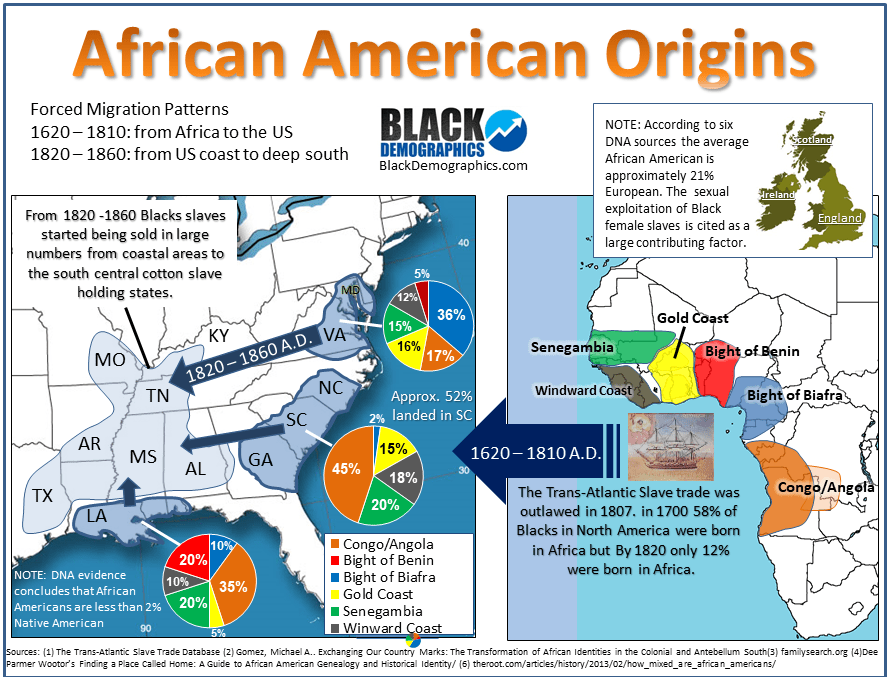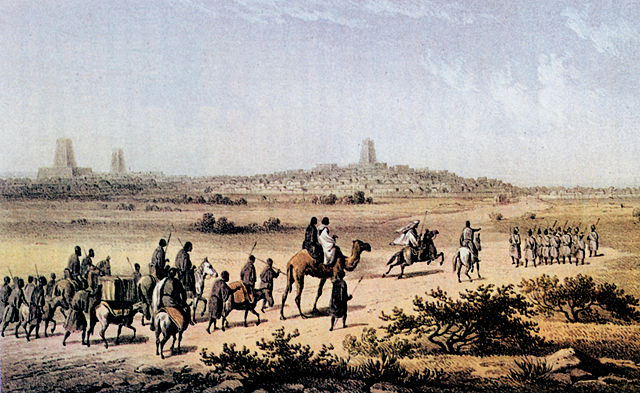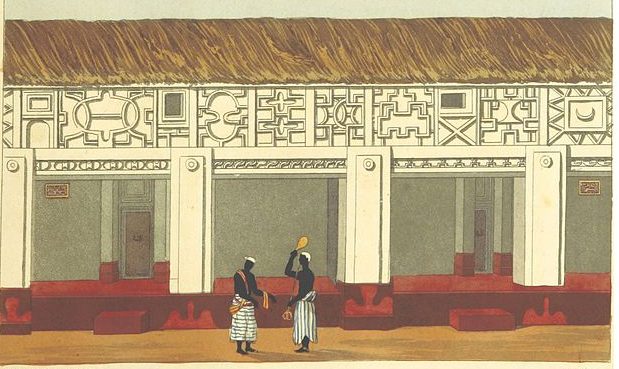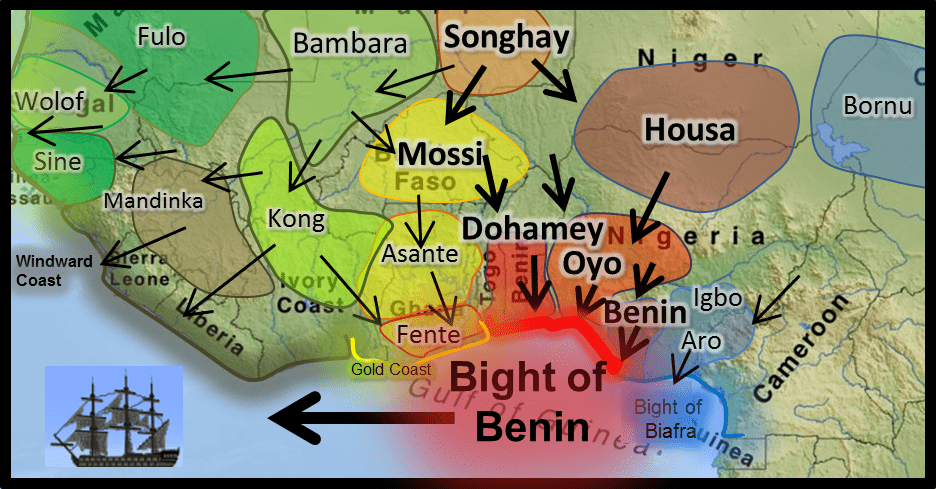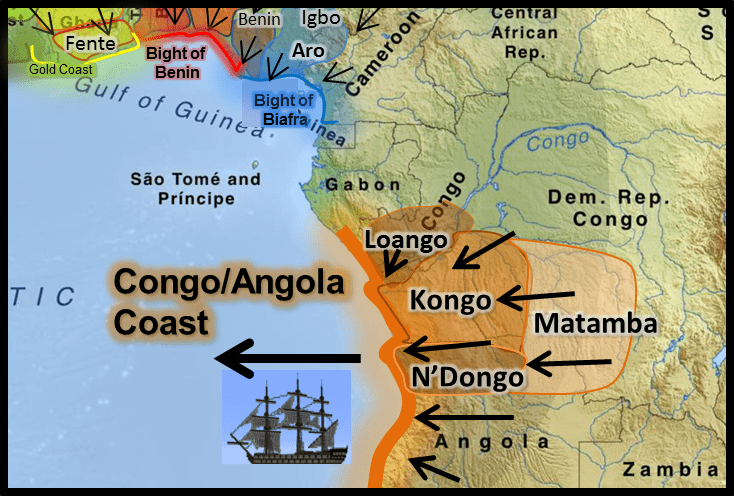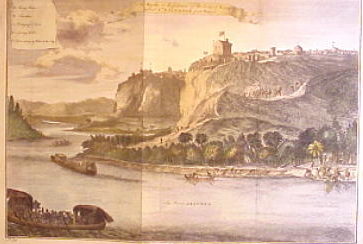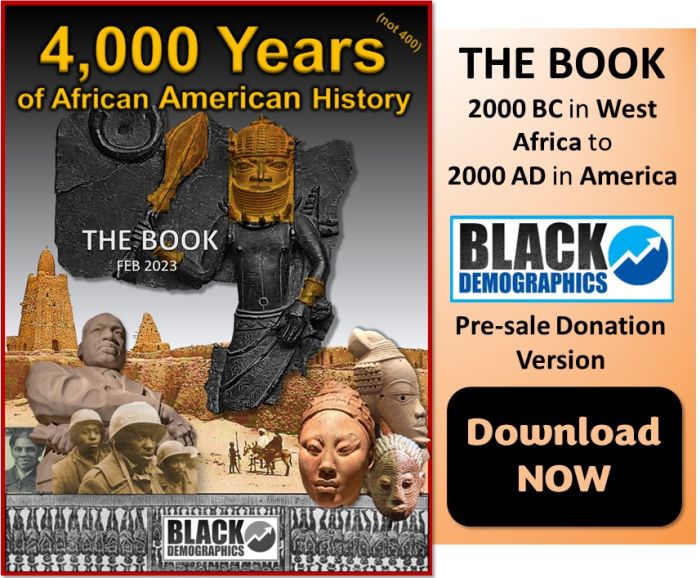African American Ethnic Heritage
Where in Africa are African Americans from?
The vast majority of Africans in bondage were imported to North America from seven general regions of Africa. The list below includes the region name, estimated percentage of Africans from each region, and location description based on current day national borders:
Senegambia (15%)

Senegambia
(green) (present day coast between Senegal and Gambia) – Senegambia includes that stretch of coast encompassing the present day nations of Senegal and Gambia. An estimated 61,500 or 15% of the total Africans that came to the United States. Captives from as far away as the upper and middle Niger valleys (present day Niger and Mali) were transported from this coast. Senegambia represented approximately 15% of All African captives transported to North America including: 17 to 19% of the captives sold in South Carolina/Georgia, 15% that were sold in Virginia, and possibly 65% of those sold in Louisiana.
Pre-colonial kingdoms of Senegambia include:
Tichitt-Walata Civilization (2000 BC- 500 BC)
Ghana Empire (300-1200 CE)
Mali Empire (1235-1600 CE)
Songhai Empire (1464-1591 CE)
Mossi Kingdoms (11th century–1896 CE)
Jolof/Wolof Empire (1350-1889 CE)
Kingdom of Sine (14th-19th century CE)
Empire of Great Fulo (1490-1776 CE)
Kingdom of Saloum (1494-1969 CE)
Kaabu Empire (1537-1867 CE)
Kingdom of Cayor (1549-1879 CE)
Kingdom of Baol (1555-1874 CE)
Ethnic groups in Senegambia include:
The Mande ethnic branch known as Malinke/Mandinko/Mandingo and the non-Mende Wolof were mainly coastal populations. Further inland were other Mande ethnic groups such as the Sereer, Fulbe/Fulani/Fula, Soninke/Serrakole from the central and upper valleys of the Senegal River. Also the Mande groups of the Bambara and the Fulbe located even further inland in what is now Mali in the floodplain of the upper Niger river.
Windward Coast (16%)
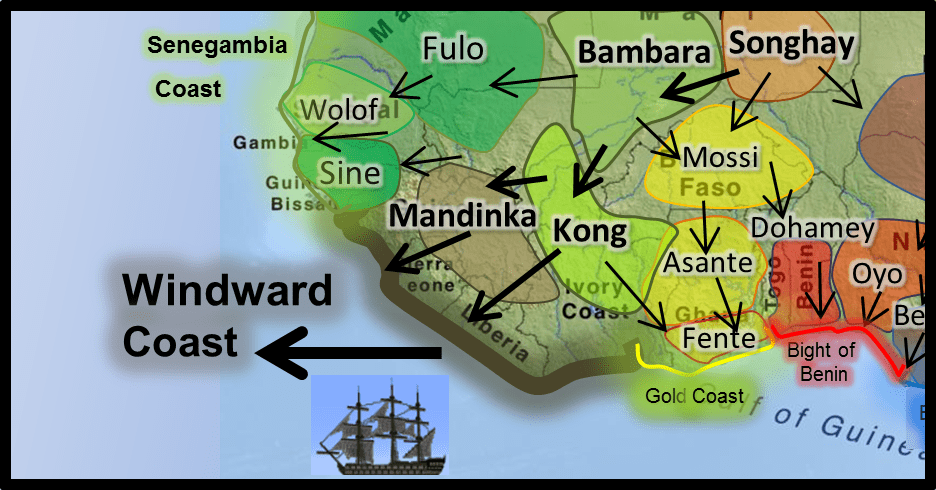
Windward Coast includes the territory from the Casamance to Assini, or what is now Guinea–Bissau, Guinea, Sierra Leone, Liberia, and the Ivory Coast. Winward Coast represented approximately 16% or 65,600 of All African captives transported to North America including: 16 percent who went to South Carolina/Georgia and 12% of captives sent to Virginia.
Ethnic groups in the Winward Coast include:
Mande ethnic groups included the Malinke/Mandinko/Mandingo, Susu, Jallonke/Yalunka, Loko, Koranko, Vai, and Kono. The closely related non-Mande were groups were Temne, Landuma, Bulom, Sherbro , and Krim. Other non Mende groups included the Kissi, Gola, Baga, and Limba. And further inland the Fulbe/Fulani/Fula and Jallonke were also in this region.
Gold Coast (13%)
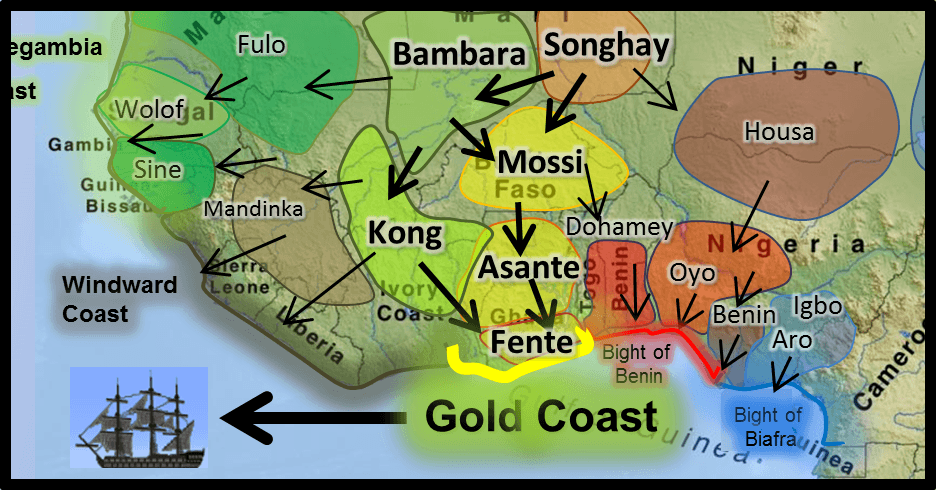
Gold Coast
Adjoining Sierra Leone is the Gold Coast, occupying what is essentially contemporary Ghana. African captives from the Gold Coast represent approximately 13% or 53,000 of all African captives sold in North America including: 13% of captives sold in South Carolina, and 16% of captives sold in Virginia.
Pre-colonial kingdoms in the Gold Coast include:
Kingdom of Dagbon (1409- Ce?)
Mamprussi (16th century CE – ?)
Ashanti Empire (1701–1894 CE)
Kong Empire (1710–1894 CE)
Ethnic groups in the Gold Coast include:
The southern half of the Gold Coast was dominated by the Akan ethic groups which include: Asante/Ashanti, Akuapem and Akyem (together known as Twi), Agona, Kwahu, Wassa, Fante (Fanti or Mfantse: Anomabo, Abura, Gomua) and Bono. Subgroups of the Bia-speaking groups include: the Anyin, Baoulé, Chakosi (Anufo), Sefwi (Sehwi), Nzema, Ahanta and Jwira-Pepesa. The Akan subgroups have cultural attributes in common, notably the tracing of descent, inheritance of property, and succession to high political office.
Bight of Benin (5%)
Further east the fourth region, the Bight of Benin, consists of what is now the nations of Togo, Benin, and southwestern Nigeria. African captives from the Bight of Benin represent approximately 5% or 20,500 of all African captives transported to North America including: 30% of the captives sold in Louisiana but not in significant numbers to other American ports.
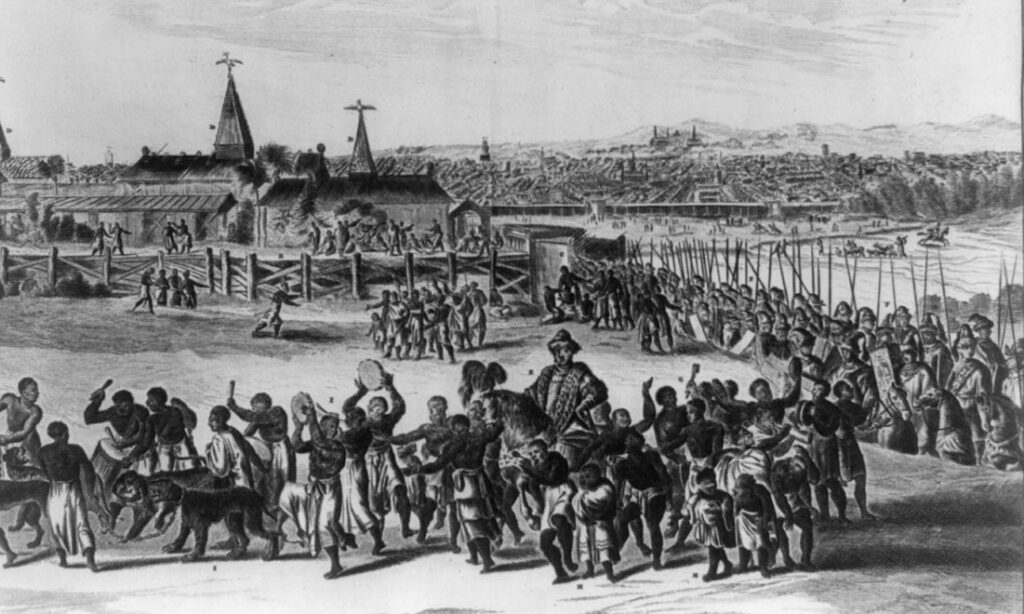
Benin City,the capital of the Benin Kingdom/Empire
Shows a number of features in Benin City: in the background the house of the queens; on the left , the royal courtyard, containing several palaces, showing their spires . The king is depicted in the center mounted on a horse with his mounted nobles in procession on the right. The king is surrounded by dwarfs, and leading the procession on the left are the musicians who are also holding the royal tigers.
Pre-colonial kingdoms of the Bight of Benin include:
Nok Culture (1,000 BC–300 CE)
Benin Empire (1180 CE–1897 CE)
Bonoman (11th–19th century CE)
Oyo Empire (1400–1895 CE)
Kingdom of Dahomey (1600–1900 CE)
Ethnic groups in Bight of Benin include:
of the Yoruba in present day Southwestern and North central Nigeria as well as Southern and Central Benin known as the Yorubaland , the Ewe who are concentrated in present day Togo, southeastern Ghana, and The Fon of Dahomey (present day Benin).
Bight of Biafra (24%)
Bight of Biafra (24%)
The Bight of Biafra is comprised contemporary southeastern Nigeria, Cameroon, and Gabon. African captives from the Bight of Biafra represent approximately 24% or 98,400 of All African Captives sold in North America including: 37%-40% of Africans sold in Virginia, 9% sold in Louisiana. and 2% sold in South Carolina/Georgia.
Pre-colonial kingdoms in Bight of Biafra include:
Sao Civilization (6th century BCE-16th century CE)
Kanem Empire (c. 700–1376)
Kingdom of Nri (948–1911 CE)
Bornu Empire (1380-1893 CE)
Sultanate of Bagirmi (1522-1897 CE)
Aro Confederacy (1690-1902 CE)
Ethnic groups in Bight of Biafra include:
The Bight of Biafra contained a number of ethnic groups, including the Igbo, the Ibibio, the Igala, the Efik, the Ijo, the Ogoni, and groups to become involved in the slave trade were the Aro, Of these ethnicities, around 75 percent of the captives from Biafra came from the Igbo-Ibibio area. famous bronzes of Benin and Ife, created no later than the tenth century C.E., are also associated with Igbo-Ukwu.
Congo/ Angola (26%)
Congo/ Angola
(brown) Represents 106,600 or 26% of the African captives brought to North America/United States. (from present day Congo, Zaire, Angola, Namibia)
African captives from the West Central Africa (from present day Congo, Zaire, Angola, Namibia) represent approximately 40% of Africans sold in South Carolina, 16% – 17% sold in Virginia, and anywhere from 5% – 36% sold in Louisiana. Also more than 90% of those who came from West Central Africa to Louisiana were from Congo, whereas less than 10% percent were from Angola.
Pre-colonial kingdoms in West Central Africa include:
Kingdom of Kongo (1400–1888 CE)
Kingdom of Ndongo (16th century-? CE)
Kingdom of Loango (1550- 1883 CE)
Kingdom of Matamba (1631-1744 CE)
Ethnic groups in West Central Africa include:
The Kongo/Bakongo/Kikongo speakers, founders of the kingdom of Kongo, include subgroups such as the Sundi, Bwende, Kamba, and Dondo, who can be further divided into the Mpangu, Ladi, Bembu, Kunyi, Yombe, Lumbu, Bussi, Puno, and Tsangui. Other ethnic groups in West Central Africa include the Bushoong, Ngunde, Pyaang, Bulaang, Bieeng, Ilebo, Idiing, Kaam, Ngongo, Kayuweeng, Kel, Shoowa, Bokila, Ngoombe, Maluk, Kete, Coofa, Cwa, Mbeengi, Leele, and the southern Mongo.
Mozambique–Madagascar (2%)
Mozambique–Madagascar, refers to the southern most region of the Swahili coast on the Indian Ocean in southeastern Africa. Captives from this region may have constituted only 2% of all African captives transported to North America including about 4% of Africans sold in Virginia.
ARRIVAL IN NORTH AMERICA
African captives landed at just three regions in North America indicated on the above map of the United States (left).
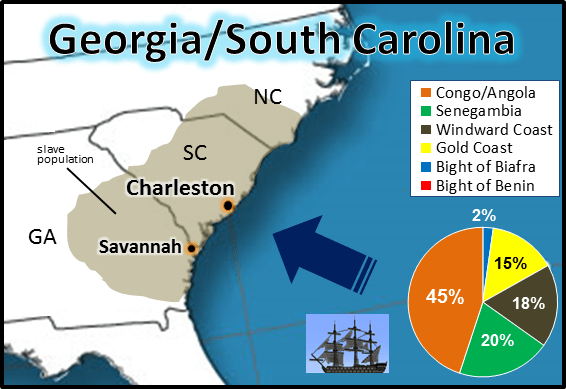
(22) Georgia/ South Carolina
Over half – 234,000 or 52% – landed in Charleston, South Carolina which was the largest slave port on the North American shore. About 45% of the African captives who landed at this port were from the Congo/Angola region which were widely available in the Americas. About 20% came from the Senegambia region where many were originally rice farmers and therefore sought after for rice plantations eventuality becoming the Gullah people of the Georgia/ South Carolina coast.
Generally plantation owners from Georgia and South Carolina refused African captives from the Bight of Biafra who were largely from the Igbo ethnic group and descendants of the Nri Kingdom. It was believed that Igbos were more likely to revolt and commit suicide rather than be slaves because they had a tradition that valued freedom. Estimates of captives brought to Georgia/ South Carolina from each region:
- 45% from Congo/ Angola
- 20% Senegambia
- 18% Windward Coast
- 15% Gold Coast
- 2% Bight of Biafra
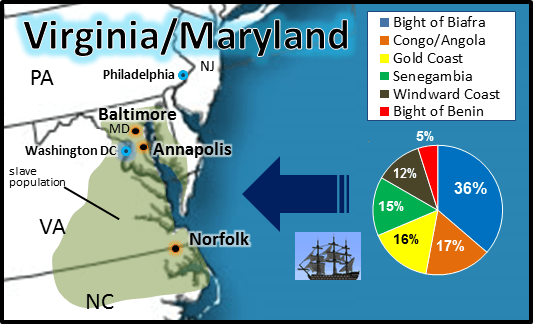
(23) Virginia/ Maryland
In direct contrast to Georgia and South Carolina, ships that supplied captives to Virginia and Maryland got the largest percentage (36%) of African captives from the Bight of Biafra. Estimates of captives brought to Virginia/ Maryland from each region:
- 36% Bight of Biafra
- 17% Congo/ Angola
- 15% from Senegambia
- 12% Windward Coast
- 16% Gold Coast
- 5% Bight of Benin
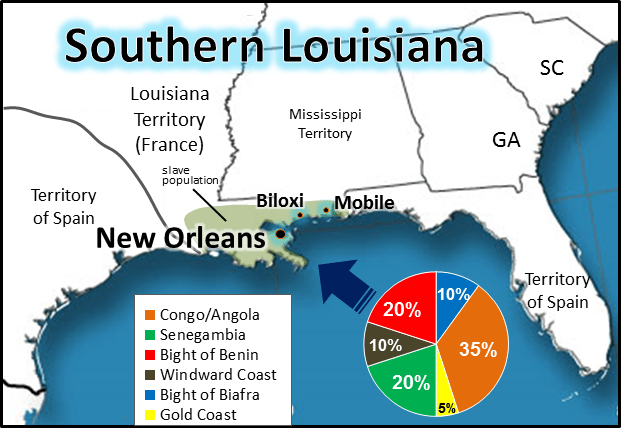
(24) Southern Louisiana
The French who controlled Louisiana imported a higher percent from Senegambia and Bight of Benin before the the United States obtained the land via the Louisiana purchase in 1803. Black New Orleans reflects some of the culture of the Yoruba ethnic group who are decedents of the Oyo Empire and Dahomey Kingdom near the Bight of Benin. Estimates into Louisiana from each region:
- 35% from Congo/ Angola
- 20% Senegambia
- 20% Bight of Benin
- 10% Windward Coast
- 10% Bight of Biafra
- 5% Gold Coast
African captives from the Gold Coast who were largely ethnic Akan people from the Asante Empire and nearby Akan states were preferred by all slave holders. However they were not as available as Congo/ Angola captives. Akan people came from societies who practiced a strict adherence to a hierarchical power structure. Many plantation owners believed this made them less likely to revolt.
The Trans-Atlantic Slave trade was officially outlawed in 1807 although some ships sailed illegally for many years after. In the year 1700 more than half (58%) of North America slaves were born in Africa but by 1820 more than 88% of slaves had been born in America. Slaves were forcibly encouraged not to pass on their African culture and identity which helped to solidify the notion of African Americans as a slave class. The African American population in 1820 was 1.7 million, 1.5 million of which were slaves.
Source: the above is a modified excerpt from our Black history power study: 4,000 Years of African American History in one Post.
NOTE: This is a work in progress and this page may contain errors if you plan on using this for school or official research projects. The African continent contains more than 1,000 ethnic groups and it’s history is just as vast. There is plenty of information missing from this narrative. Feel free to contact me to identify any errors or to add any content that is needed. This subject will be expanded as time for research allows. This page lacks inline citations due to source-content blending.


